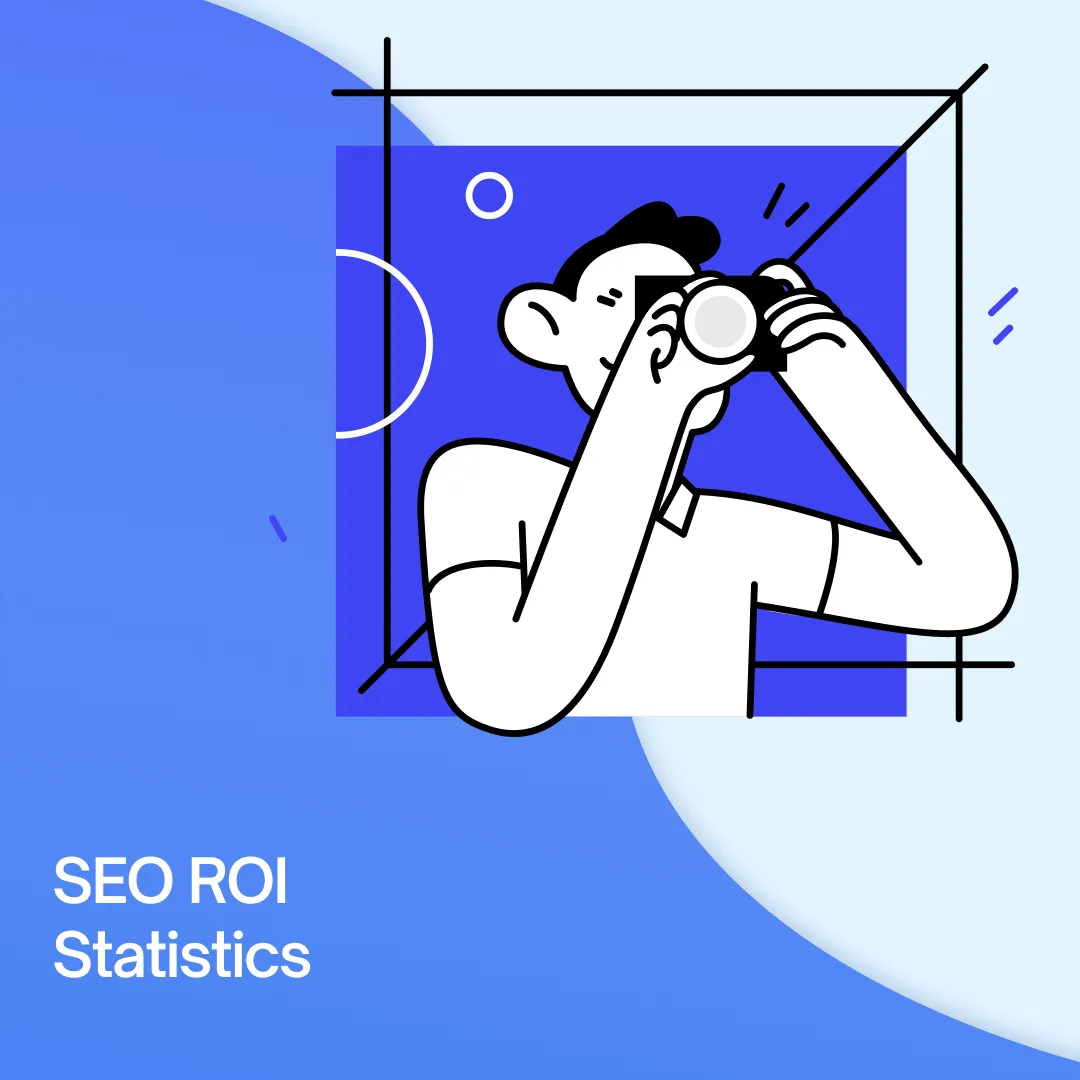Studies show that 90% of potential customers say user-generated content (UGC), like customer reviews and social media posts, influences their purchase decisions. This means UGC is arguably better than traditional marketing methods when it comes to actually buying.
But UGC has another advantage:
This marketing tactic has become genuinely important for SEO performance and search visibility.
For example, sites featuring UGC see visitors spend up to 90% more time on site. And visit length is an essential ranking signal.
Here’s why user-generated content is essential for SEO in 2025:
- Authenticity builds trust & social proof: Real voices (reviews, photos, Q&A) signal credibility to both users and search engines.
- Engagement signals amplify ranking potential: UGC drives comments, shares, repeat visits, thus increasing dwell time and lowering bounce.
- Search visibility via content diversity & freshness: Customer content introduces natural long-tail keywords and keeps your site evolving.
In this blog post, we’ll illustrate this with real brand examples and walk you through 8 proven ways to use UGC in SEO, plus content writing best practices to get them right.
TL;DR
UGC such as reviews, testimonials, and social posts builds authenticity, improves engagement, and expands keyword coverage.
Freshness, diversity, and trust are the three main SEO pillars UGC supports.
Key benefits include natural keyword expansion, better engagement metrics, higher CTR through rich snippets, backlink growth, scalable content generation, and stronger customer trust.
Proven Tactics to Apply UGC for SEO
- Scale influencer collaborations and repurpose their content into SEO assets.
- Use branded hashtags to collect content and integrate it onsite.
- Ask customers and creators to republish their UGC for reach and keyword diversity.
- Run UGC contests to generate authentic, linkable content.
- Enable photo and video uploads in product reviews for rich snippets and engagement.
- Repurpose high-performing UGC into blogs, landing pages, and case studies.
- Partner with TikTok creators and optimize captions for search visibility.
- Leverage product gifting and seeding to gather authentic reviews and content.
Implementation Essentials
- Always embed UGC on product pages, blogs, and landing pages for crawlability.
- Run keyword analysis on UGC to identify long-tail opportunities.
- Fill content gaps by creating new assets around user language.
- Secure usage rights, credit creators, and foster long-term relationships for sustainable campaigns.
Measurement
- Track rankings, organic traffic, CTR, engagement, backlinks, and conversions.
- Use GA4, Search Console, and SEO tools like Ahrefs or SEMrush for performance insights.
Takeaway: UGC is a scalable SEO growth engine that improves rankings, traffic, and conversions when applied strategically and measured consistently.
What Is UGC?
UGC refers to content made by your customers, fans, or community. This is not content created by your internal marketing team, although, in some cases, you can use UGC creators who create this kind of content for a living.
In an SEO context, user-generated content includes:
- Product reviews
- Blog comments
- Social media posts
- User-uploaded images or videos
- Forum threads
- Q&A contributions
- Transcripts of user interviews or testimonials
The key lies in the fact that it originates from users themselves, without brand scripting or paid production.
Why UGC delivers ROI
Brands that incorporate user-generated content, like customer reviews, testimonials, and visuals, consistently see higher returns across general optimization and, more importantly, organic traffic growth.
Just look at the numbers:
- PowerReviews found that exposure to user-generated content correlates with a 3.8% lift in conversion rates on product pages.
- The American Marketing Association reports campaigns built around UGC achieve 29% higher web conversions compared to those without customer content.
Those conversions translate into ROI.
So UGC is a trust-builder, yes, but also a performance driver for brands aiming to scale both search visibility and sales. Because UGC performs well in terms of ROI, it’s not just supplemental. It becomes a core asset in your SEO strategy.
Why Use UGC for SEO?
UGC is a strategic SEO lever built on three pillars: freshness, diversity of content, and user trust. Below, we walk you through how user-generated content delivers on each, show real brand examples, and outline core UGC formats to leverage.
1. Freshness
Every new review, comment, or Q&A signals to search engines that your website has relevant content and is up-to-date. UGC delivers this continuous flow of fresh content without heavy production work. This helps your pages stay relevant to new queries.
2. Content Diversity
Users describe your products in their own words, adding synonyms, long-tail keywords, and natural language you might not target otherwise.
You can see a great example of keywords and synonyms in this review below:
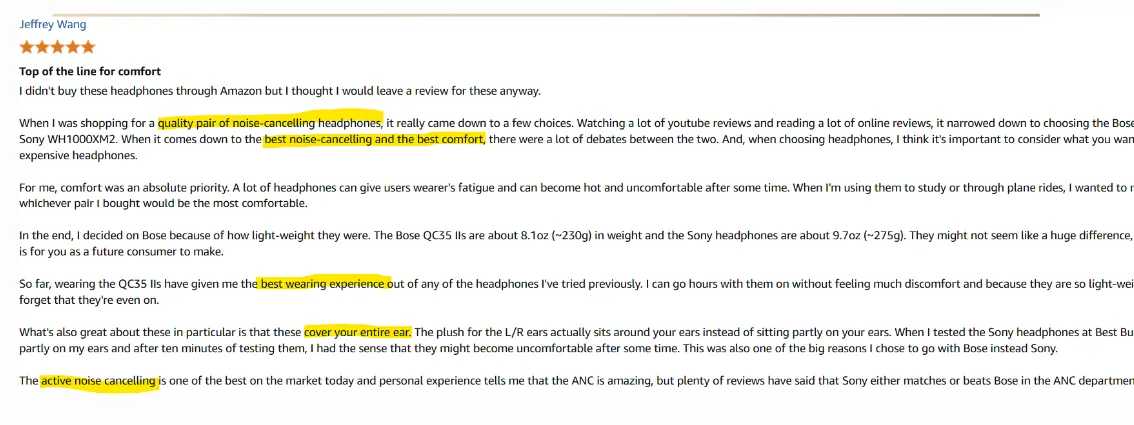
With UGC spanning text, images, and videos, you get richer content that covers more search intent.
3. User Trust & Social Proof
People trust peer reviews and real stories more than brand copy. In fact, 84% of your customers are more likely to trust your brand if you’re using UGC. That’s because UGC increases credibility and keeps visitors engaged longer. This kind of engagement sends positive signals, like dwell time and repeat visits, back to search engines.
Brand Examples of UGC Driving Organic Growth
- GoPro has leaned heavily into UGC by running regular contests and featuring customer videos on its site and social channels. This effectively turns its user base into a content engine.
- Starbucks launched its ‘White Cup Contest’ on social media platforms, inviting customers to decorate their cups and share them as social media posts. This campaigned had a large viral reach because it relied on massive user content.
- ASOS’s “As Seen On Me” feature allows customers to share their outfits on product pages. This is a good tactic to increase brand engagement and even search visibility through some unique visuals.

- Fenty Beauty encourages followers to tag #FENTYFACE with their own makeup looks. Adding hashtags to these authentic customer posts increases the visibility even more. So, the brand received an even bigger stream of genuine content that they could embed, repurpose, or showcase.
UGC Formats You Should Know
When these formats layer over your branded content, you get a richer, more natural content ecosystem. This type of content helps search engines interpret, index, and rank you more broadly.
These cases show UGC’s power in scaling reach, enriching content, and fueling organic growth. But if you want to understand more benefits of UGC for SEO, read the section below:
Benefits of UGC for SEO
When incorporated into your SEO strategy, user-generated content brings incredible advantages. Below are the key benefits:
1. Natural keyword diversity & long-tail reach
Because real users write in their own voice, their customer reviews, blog comments, and Q&A often include phrases and long-tail keywords you may not always explicitly target in your website content. This broadens your search visibility across more queries.
2. Freshness signals & relevant content freshness
Every new comment, product review, or upload keeps your pages alive. Search engines view UGC as “information gain”. These fresh perspectives warrant more frequent crawling and indexing, so they increase organic traffic.
3. Increased engagement & improved content engagement metrics
User-generated content encourages users to read more, comment, vote, and explore. So, if you add UGC to your website, you get better dwell time, lower bounce rates, and more pages visited per session. These are positive behavioral signals for search engines evaluating engaging content.
4. Enhanced SERP presence: rich snippets & social proof
Customer reviews and ratings can be wrapped in structured data (schema) to trigger rich snippets (e.g., star ratings) in search results. This improves CTR. User-generated content also strengthens social proof, making your listings more compelling.
5. Backlink potential & organic search gains amplification
High-quality user-generated content is shareable and is more likely to be embedded or cited by other websites. This can generate natural backlinks, improve search visibility, and amplify referral traffic.
6. Scalability of content generation
UGC lets you scale content creation without scaling headcount. The more your audience contributes customer posts, photos, or Q&A, the more content for SEO you accumulate with less ongoing effort.
7. Stronger trust that feeds SEO & conversions
User-generated content builds authenticity and trust. As we explained above, consumers see real feedback more favorably than brand copy. That trust improves customer experience, encourages engagement and conversions, and reinforces SEO value.
8 Ways to Leverage UGC for SEO
Once you’ve built a pipeline for collecting and curating user-generated content, the next step is to make it work for your SEO goals.
Remember: UGC isn’t just social proof. It’s a scalable asset that can drive rankings, fuel content engagement metrics, and broaden your long-tail keyword reach when used strategically.
Below are eight proven ways to apply user-generated content for search visibility, performance, and organic traffic growth. We’ve paired each with tools, brand examples, and best practices you can act on now.
1. Scale Collaborations with Influencers
Influencers bring niche authority, authentic voices, and highly engaged audiences. But to unlock real performance, our clients Hurom and Lactomedi go beyond one-off posts. We help them build a repeatable cycle: influencer user-generated content→ SEO-rich articles → paid amplification → measurable growth in organic search traffic.
Influencers Drive More Than Awareness
Take Hurom: Chef Ana Machado, personal chef to NFL star Nick Bosa, creates user-generated content showing real-life juicing moments.
.webp)
Nick Bosa himself also features in Hurom’s content, giving the brand crossover appeal and social media strategy momentum. And Hurom embeds these videos on their website:
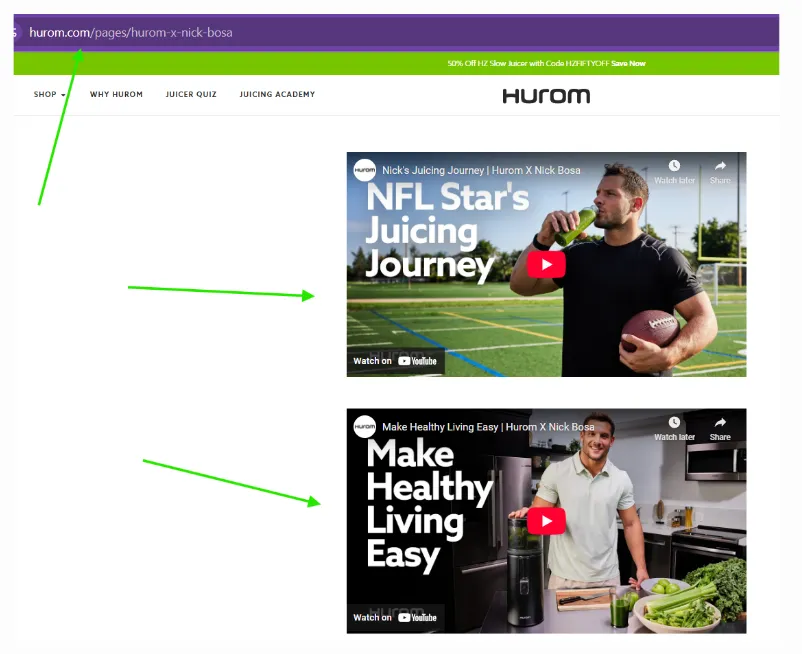
Besides, Chef Ana’s videos and recipes aren’t just for social media use, either.
When embedded on YouTube, they capture user search intent around queries like “best cold-press juicers” or “Nick Bosa diet juicing.”
That’s extremely important because YouTube is part of Google’s ecosystem.
Ana Machado also wrote long-form articles like Best Cold-Press Juicers: A Chef’s Guide for Hurom on her own website.
Review articles like these rank for evergreen long-tail keywords and give your brand lasting digital visibility. Besides, since they aren’t published on your website, they signal credibility to both Google and LLMs, so you can rank higher and get more citations in AI overviews or GPT search.
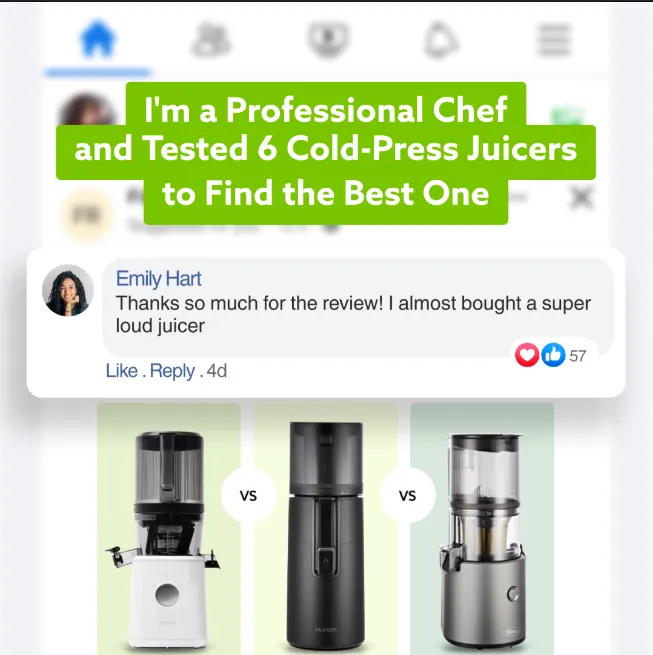
Similarly, Lactomedi partners with Dr. Kristina Telhami, whose expert reviews on hormone-safe products become high-performing blog content like Best Intimate Care Products: A Functional Medicine Guide.
From Content to Amplification: A Scalable Playbook
Once articles go live, our clients run ads not only on influencer videos but also on the SEO-rich articles themselves through our colleagues at inBeat Agency:
- Hurom ads drive traffic to Ana’s juicer product reviews, boosting on-page engagement, branded search interest, and, as a result, organic search gains.
Of course, they always test different variations to maximize each ad’s impact:
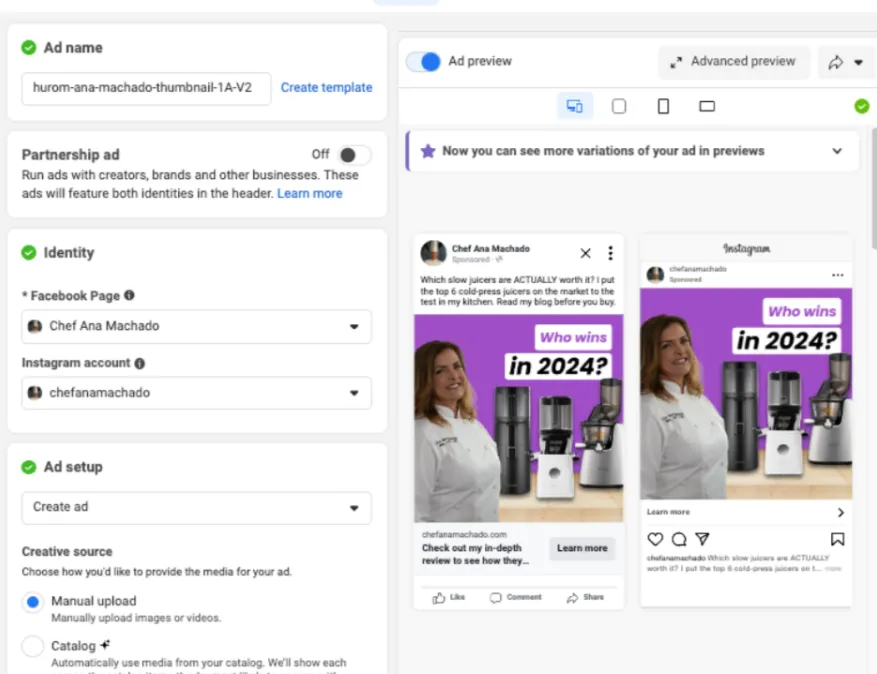
- Lactomedi does the same with Dr. Telhami’s articles, ensuring expert-driven user-generated content reaches bigger, more targeted audiences.
This paid + organic loop makes influencer content work harder, turning every collaboration into a long-term SEO and brand engagement asset.
Scaling With Tools and Systems
To make this repeatable, you can rely on:
- Influencer platforms (e.g., Upfluence, Traackr) to manage partnerships.
- Content usage rights tools (e.g., Emplifi) to handle licensing and tracking.
- Simple mapping systems (spreadsheets, ClickUp) linking influencer → content → SEO page → ads.
With the right workflow, influencer collaborations scale across channels while staying organized, measurable, and SEO-optimized.
2. Use Hashtags to Encourage UGC
Branded hashtags are one of the most efficient ways to prompt and collect user-generated content at scale. When integrated into product packaging, email campaigns, and social media posts, they make it easy for customers' posts to be shared, tracke,d and repurposed for content creation.
Like so:
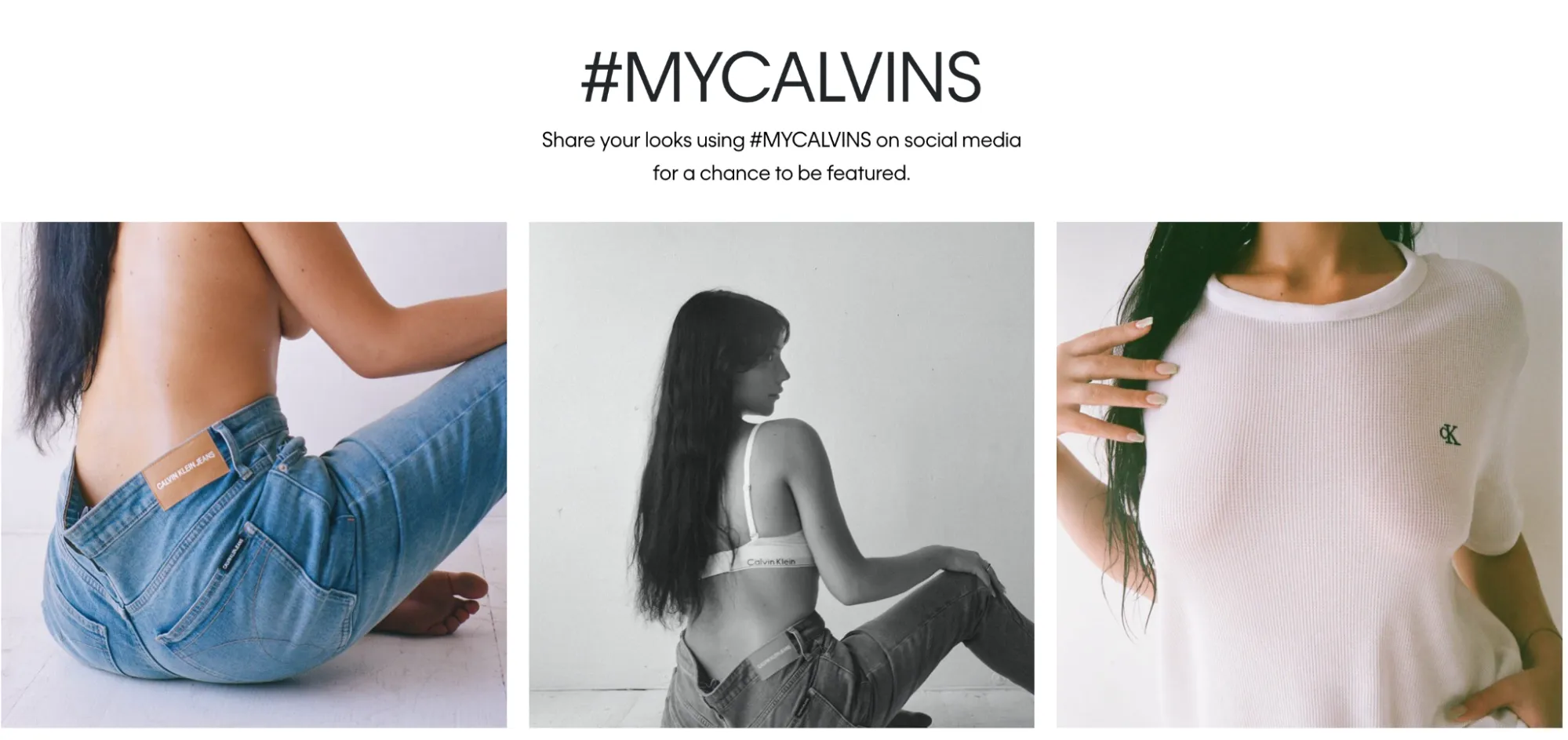
The SEO value comes from discoverability and keyword expansion.
For example, hashtagged posts contain natural language and long-tail keywords, which is great for keyword expansion.
Even better, you can repurpose these across blog posts, galleries, or product category pages. Tools like Taggbox or Walls.io will help you aggregate and embed this content onsite to support both search visibility and social proof.
Pro tip: Promote your hashtag consistently, but ensure you secure content usage rights before republishing.
3. Ask Customers and Creators to Republish Their UGC
Encouraging customers and creators to share user-generated content on their own social media accounts expands your reach to new people. These are your customers’ (or creators’) highly engaged followers.
This relationship is based on trust and mutual knowledge. As such, your buyers/ creators can produce genuinely engaging content with greater authenticity than branded ads.
Tips:
- Promote your branded hashtag across social media platforms, email, and packaging so customers can easily tag and share.
- Give creators pre-approved visuals, captions, or access for resharing.
- Incentivize reposting by featuring top customer creations on your website or blog.
The result? A growing library of authentic, keyword-rich user-generated content that improves search engine rankings and social proof for your brand.
4. Hold a UGC Contest
UGC contests quickly spark user participation and generate fresh, relevant content. Photos, videos, and customer reviews continue to benefit SEO long after the campaign ends.
That’s because entries include long-tail keywords, generate editorial links, and expand organic search traffic when participants share them across social media platforms.
We encourage you to use tools like Woobox or ShortStack; they make launching and moderating really easy.
Also, repurpose winning user-generated content on landing pages or blogs, and link to target content for SEO amplification.
Of course, as we said above, you should always secure content usage rights upfront.
Real-life example: Doritos’ long-running “Crash the Super Bowl” contest invited fans to create and share their own video ads for a chance to have them aired during the Super Bowl. Participants posted their entries across social media and video platforms.
This generated thousands of pieces of authentic content, widespread press coverage, and valuable backlinks, all of which boosted Doritos’ visibility well beyond the campaign itself.
5. Enable Customers to Upload UGC in Product Reviews
Allowing customers to add photos and videos to product reviews turns these pages into SEO-rich assets.
However, you have to use structured data for it to work.
That way, customer reviews can trigger rich snippets (e.g., star ratings) in search results, increasing search visibility, CTR, and customer experience trust signals.
Not sure how to get started?
Our in-house experts use platforms like Yotpo, Judge.me, and Stamped.io to streamline collecting multimedia reviews while capturing natural language and long-tail keywords that users naturally include.
Pro tip: To make sure this tactic is even more productive, we encourage you to always set clear guidelines for submissions. That way, you’ll be getting the kind of UGC that leverages gaps/ opportunities in your strategy and genuinely contributes to your SEO.
6. Repurpose and Promote Existing UGC
Transform top-performing user-generated content, like influencer posts, customer reviews, or even user-generated images, into blogs, case studies, or landing pages. Embedding authentic content adds engaging content, long-tail keywords, and content for SEO value.
Of course, you need to do some solid keyword research before these contests to gain organic traffic.
Next, promote the assets your customers created across social media platforms, email, and paid campaigns, and you’ll get some good results. From our experience, it’ll:
- Boost organic search gains
- Extend reach
- Funnel traffic back to optimized pages
That way, your best UGC keeps working for both visibility and rankings long after the initial post.
Case in point: Le Col.
The premium cycling gear brand repurposes customer reviews and authentic lifestyle images across its website, product galleries, and retail partner sites.
Embedding UGC into multiple touchpoints lets Le Col create fresh, keyword-rich content that Google can crawl and index. Reviews naturally introduce long-tail phrases (e.g., “best cycling jersey for long rides”) and synonyms the brand wouldn’t have thought to target.
Besides, customer images (when properly tagged and captioned, of course) strengthen image search visibility.
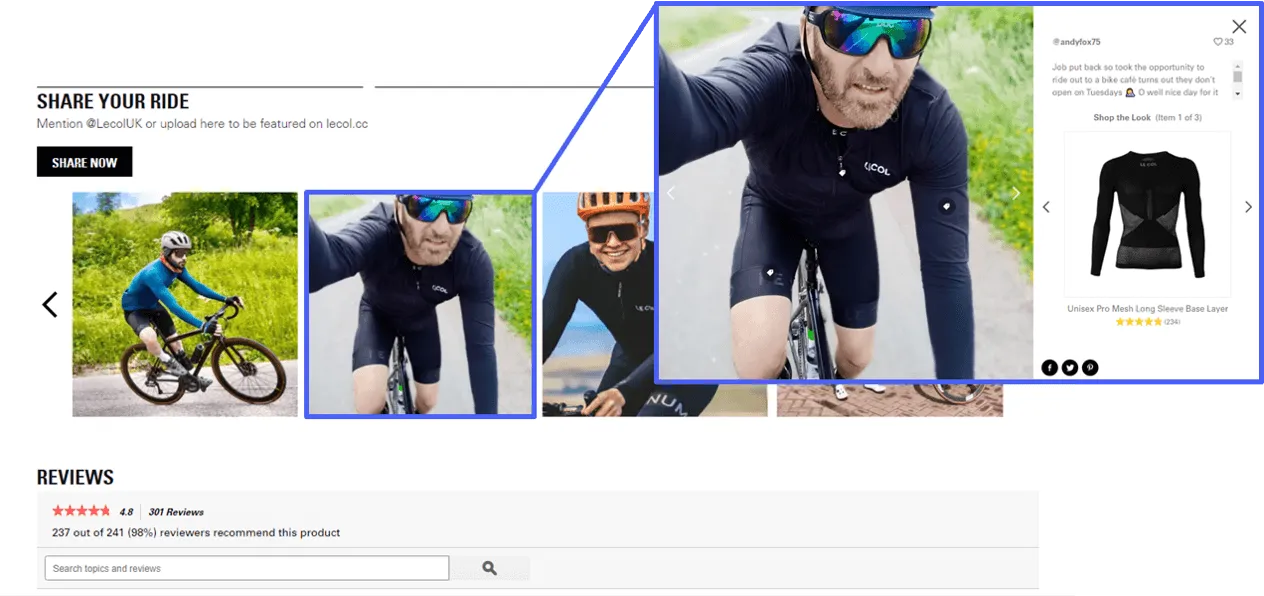
Le Col also syndicates its top-performing UGC to retailers through Bazaarvoice, which means those reviews and visuals generate backlinks and citations from high-authority retail domains. This combination of fresh content, diversified keywords, and distributed signals improves organic rankings for both branded and non-branded search queries.
The payoff: products with reviews saw a 13% higher average order value, a 155% increase in revenue per visitor, and a 125% jump in conversion rates. According to Andrew Longley, Head of Digital, reviews are “as important to new customers as our own product claims,” which is why UGC now anchors both their ongoing SEO strategy and product launch campaigns.
7. Partner with UGC Creators and Affiliates on TikTok
TikTok creators can generate authentic customer posts and product demos.
But it gets better: TikTok videos are now ranking in Google and influencing AI-driven search engines.
The opportunity lies in treating TikTok uploads like SEO assets, not just social content.
When you create a TikTok, think about the search queries your audience would type into Google. Place those keywords at the very beginning of your video description, and take advantage of TikTok’s generous character limit to add a longer, keyword-rich caption. This text is crawlable, so it helps Google understand what your video is about. If your video gains decent engagement on TikTok itself (likes, comments, watch time), Google interprets that as a signal of credibility and pushes it higher in search.
Here’s a more in-depth explanation and how to leverage this strategy:
To maximize this tactic, repurpose TikTok user-generated content on your landing pages, blogs, and product hubs to capture trending long-tail keywords and drive cross-platform search visibility.
You can also upload the same short-form content to YouTube Shorts or Instagram Reels to increase the odds of it being indexed in search. Because these platforms distribute differently, a single 30-second video optimized with keywords can show up multiple times across different surfaces of Google.
The real power here is speed and freshness.
While long-form articles are now increasingly bloated with AI-generated content, Google sees TikTok as authentic and fast-consumed. People also prefer short answers for many queries, so a 15-second demo or tip can outrank a 3,000-word blog post.
In short: optimize your TikTok descriptions, use strategic keywords, focus on engagement, and cross-publish your content.
This approach merges creator credibility with SEO reach, thus increasing your brand’s relevance in both TikTok and Google search results.
8. Gather UGC via Product Gifting and Seeding
Product gifting helps you get authentic user-generated content from influencers, employees, or even loyal customers through customer reviews, photos, or unboxing videos. This content naturally aligns with user search intent and niche keywords, thus increasing SEO value.
Even more, this type of content aligns with user search intent, improves customer experience, and fuels organic search gains for your site.
For example, Hurom uses affiliates who write reviews like this:
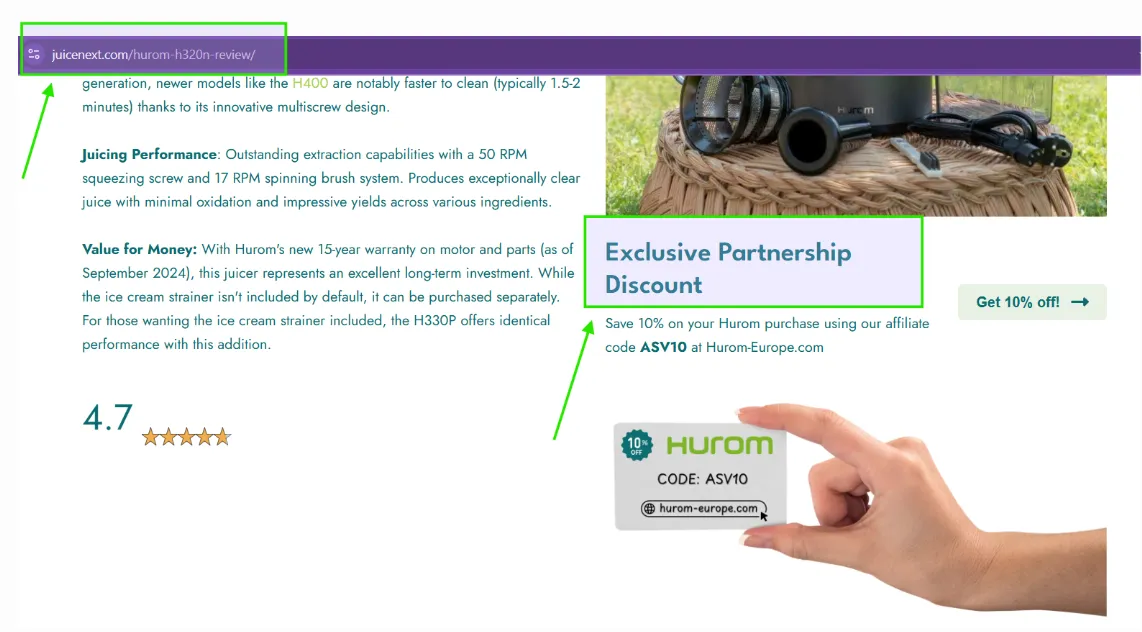
The main keyword here is something really aligned to people’s buying intent: “Hurom H320 review.”
And since this is an article meant for the European audience, we can notice other target keywords that increase the article’s total monthly volume:

Use tools like Cohley or Influenster to manage gifting campaigns, collect content usage rights, and track submissions. Repurpose the best content into landing pages, blog posts, or category intros.
But always remember to follow disclosure rules and ethical guidelines for gifted content.
Integrate UGC into Your Website
For user-generated content to deliver real SEO impact, it can’t live exclusively on social media platforms. It needs to be embedded where search engines can crawl it and potential customers can engage with it. That means strategically placing customer reviews, user-generated images, videos, and Q&A content across key parts of your site, like:
- Product pages: Add customer reviews, star ratings, and user-generated images for richer product experiences and potential rich snippets in search results.
- Landing pages: Feature authentic customer posts, quotes, or influencer videos to improve customer experience, brand engagement, and conversion rates.
- Blogs and resource pages: Embed user-generated content examples or testimonials into guides and articles to add real voices and long-tail keywords, and relevant content for better search visibility.
Tools and Optimization Tips
Platforms like Bazaarvoice, Taggbox, or Yotpo make it easy to collect and embed user-generated content directly on your site. Focus on high-traffic pages first to maximize organic search gains, then expand to product category pages or niche content fields for broader SEO coverage.
For local SEO, integrate user-generated content, especially customer reviews, into your Google Business Profile and location pages. Search engines prioritize recent, authentic customer posts when ranking local results, so fresh UGC here can drive both search visibility, social proof, and trust.
Advanced UGC Tactics for SEO
Once you’ve integrated user-generated content across your site, the next step is to mine it for SEO insights. Treat it as a keyword volume discovery engine rather than just a content creation source.
1. Run Keyword Analysis on UGC
Customer reviews, Q&A threads, and social media posts are packed with long-tail keywords and real-world search query phrases you may not be targeting yet.
Use tools like Ahrefs, Surfer SEO, or Frase to extract these terms directly from user-generated content for better search visibility.
For example, a series of product reviews mentioning “best cold-press juicer for small kitchens” signals a long-tail query you can optimize for with dedicated content or product category page copy.
But let’s get back to Juice Next’s article on the Hurom H320.
We already showed you the secondary keywords it targets by using Ahrefs. Now, Frase can give us a more complete picture if we just copy-paste the article into this app:
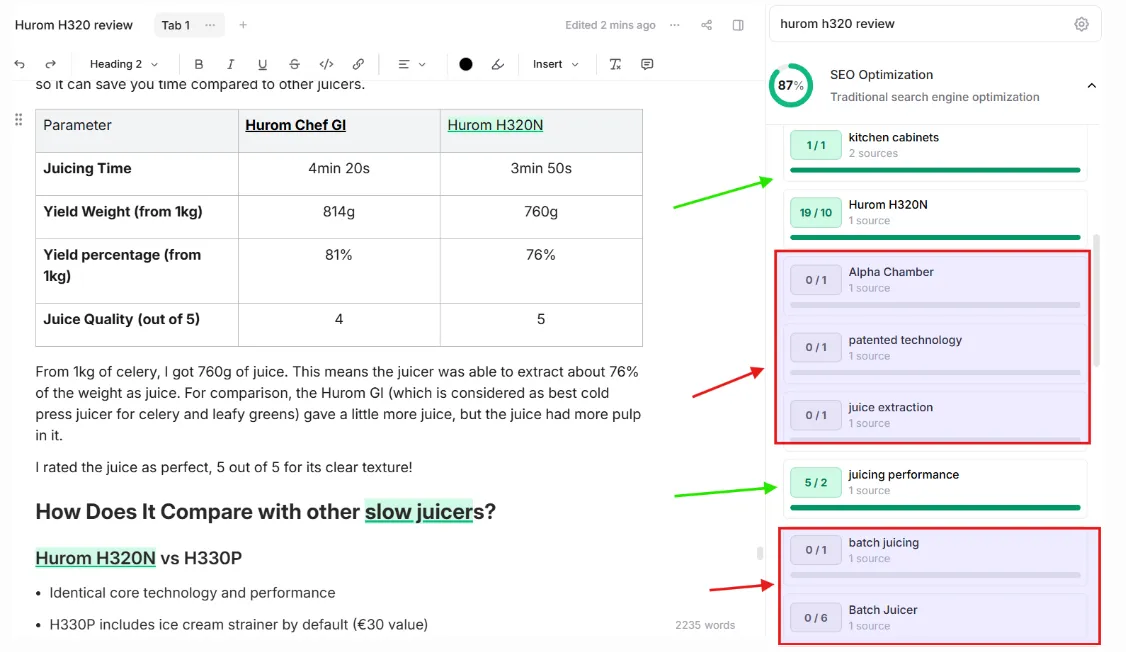
As you can see, the app shows you keywords that are already used as well as gaps you can exploit:
- Terms like “Alpha chamber” and “patented technology” let you write BOFU articles about Hurom products
- Terms like “batch juicing” indicate an opportunity for TOFU content
That brings us to the next point:
2. Fill Content Gaps with Real User Language
Once you’ve pulled these insights, analyze them for content issues and gaps. Identify questions or needs your potential customers are voicing, but your site hasn’t addressed.
Tools like AlsoAsked, Ahrefs, and Surfer SEO help cluster related queries, so you can create authoritative content like blog posts, FAQ sections, or landing pages targeting the actual language people use.
Let’s say that, from the analysis above, we decide to expand our content with batch juicing. Add this term in AlsoAsked, and here’s the slew of other opportunities we can technically consider:
.webp)
This approach strengthens your content for SEO strategy, ensures your pages feel more relevant content, and aligns better with user search intent for organic search gains.
UGC for SEO: Ethical Considerations and Best Practices
Leveraging user-generated content for SEO comes with responsibilities. To keep campaigns and brand engagement safe, transparent, and sustainable, follow these three best practices:
1. Secure Explicit Permissions
Always obtain clear, documented content usage rights before republishing customer posts or user-generated images. Platforms like Emplifi simplify rights management and ensure you stay compliant while scaling UGC efforts without risking potential SEO issues or violating acceptable content guidelines.
2. Maintain Transparency and Credit Creators
Crediting contributors builds trust, improves the customer experience, and encourages more customer-generated content. Add attribution in captions, embeds, or even article bylines so creators feel recognized and valued. Transparency also reinforces credibility with both audiences and search engines, improving social proof and content engagement metrics.
3. Build Long-Term Relationships
Treat user-generated content contributors as community partners, not one-off participants. Involving repeat creators in future campaigns, product feedback loops, or ambassador programs fosters loyalty, improves brand engagement, and ensures a steady flow of content for SEO.
As a result, your user-generated content initiatives are legally sound, sustainable, and beneficial for both your brand and potential customers.
How to Measure UGC Impact on SEO
To understand how user-generated content drives your SEO strategy, focus on the metrics that show real performance impact:
Key Metrics to Track
Tools for Measuring UGC Performance for SEO
- Google Search Console and GA4 for traffic, CTR, and user behavior data
- Ahrefs or SEMrush for backlink tracking and keyword rankings
- Hotjar or Microsoft Clarity for engagement heatmaps and on-page insights
Refine Your UGC SEO Strategy
Use this performance data to double down on UGC types and campaigns driving the most SEO value. For example, if review pages deliver higher CTR and conversions, expand UGC integration across other high-traffic pages.
At Bluethings, we always tie our tactics (UGC included) to measurable SEO outcomes. It’s the best way to refine our efforts based on real impact rather than assumptions.
Turn UGC into an SEO Growth Engine
User-generated content is no longer just a brand engagement tool. It’s a performance driver across SEO. When you bring UGC into the mix through influencer collaborations, product reviews, hashtag campaigns, and the other tactics we’ve covered, you build a system where authenticity drives engagement, search visibility grows, and the results are easy to measure.
The eight strategies in this guide show how to move from simply collecting UGC to actively using it to amplify SEO impact. When applied consistently, with ethical best practices and clear measurement, UGC becomes a scalable growth asset that boosts rankings, drives traffic, and builds trust over time.
We advise you to start small: pick one tactic to implement this quarter.
Then build your UGC loop, collect, optimize, publish, amplify, and watch as user content turns into a repeatable engine for organic growth.
Want expert help turning UGC into SEO wins? Contact Bluethings to build a tailored strategy that scales your brand’s visibility and performance.
FAQ
What types of content can boost both engagement and SEO?
The types of content that work best include user-generated reviews, case studies, short-form videos, and evergreen blog posts. Mixing these formats creates a diverse pool of content that keeps audiences engaged and gives search engines more material to index.
How important is the quality of content compared to quantity?
Quality of content always wins over sheer volume. A single killer blog post or well-researched blog series can outperform dozens of thin updates. High-value onsite content also keeps readers engaged longer, which signals credibility to search engines.
What is considered problematic content from an SEO perspective?
Problematic content includes duplicate text, misleading claims, or keyword-stuffed pages that add no real value. Content marketers should also avoid publishing filler or “sample content” that lacks depth, as it can undermine trust and visibility.
How are content consumption habits changing?
Content consumption today is fragmented: people scan reviews, watch quick TikToks, or skim articles. Social media marketers can maximize reach by integrating social media buttons into onsite content, making it easy for users to share what resonates most.
What counts as permissible content when using UGC?
Permissible content refers to reviews, images, or posts that you’ve obtained clear user consent to use. Brands should only repurpose UGC in campaigns or onsite galleries once it’s been approved by the creator.
How can smart automation support scaling content efforts?
Smart automation helps content marketers and social media teams handle a high level of scale without sacrificing quality. Scheduling tools, content curation platforms, and AI-assisted editing can streamline workflows while keeping messaging consistent.




